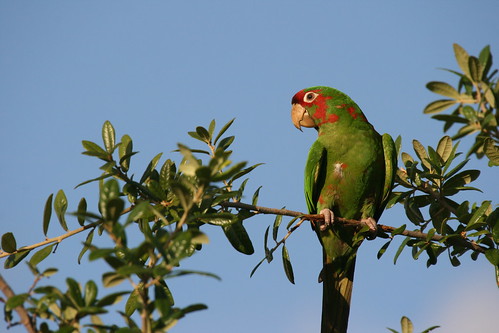Wild Neighbors: Probably the Last Parrot Column
 Wednesday, January 28, 2009 at 3:50
Wednesday, January 28, 2009 at 3:50  Mitred parakeet (Aratinga mitrata) in Fort Lauderdale, FL
Mitred parakeet (Aratinga mitrata) in Fort Lauderdale, FL
The parrot reports keep coming in. (For anyone who got here late, I had asked readers for any information on the red-and-green parrots, conures, or parakeets that frequent northwest Berkeley. Based on the response, the flock consists of four mitred parakeets, AKA mitred conures, and they’re seen most often in the vicinity of James Kenney Park. Most of the sightings have been fairly recent, although Steve Halflich has been observing them for 19 years.)
Here’s an origin story, from M. Chapelle: “Years ago I lived on University Avenue near Martin Luther King Jr. Way. This was ‘85 to ‘89. One day I heard a large crowd of people outside and went to see them all standing around a tree, looking up at four noisy parrots. I mentioned this to a friend and long-time Berkeley resident. He told me they were known locally as the ‘gang of four’ and that they had escaped from the Lucky Dog Pet Shop on San Pablo Avenue near University.”
So maybe there never were all that many. Even a small number of parrots can seem like a crowd. But Ruth Bird, on Curtis near Cedar, writes: “There have been four for about two or three years. Before that, there were eight.” What’s clear is that the Berkeley parrots, unlike the red-masked parakeets in San Francisco, haven’t been reproducing lately, if at all. Male and female mitred parakeets are identical in size and plumage, so it’s entirely possible that the survivors are all of the same sex-or they may simply be too old. (Closely related parrot species have lived into their early 30s.)
The Lucky Dog, where the cult science fiction writer Philip K. Dick used to buy frozen horsemeat for personal use, has changed hands since then, and I doubt that the current owners would know anything about long-ago escapes. (As you may remember from the Wild Parrots of Telegraph Hill movie, San Franciscans have a variety of stories about how that flock came to be, including several variants of the escape from the pet store.)
I reported last week that the parrots have been visiting a bird feeder on Tevlin Street near Gilman. Carol Beth identifies another recent feeding site, as well as a roost: “At least five years ago, some of the wild parrots moved into the eaves of an apartment house at 1013 and 1011 Delaware Street. They moved out a family of grackles and took over their ‘house.’ I watched all this from our backyard as the back of the apartments border our yard. We’ve seen them there until this winter when I noticed they seemed to be gone. A man in the 1800 block of 9th Street always fed them, but I haven’t seen them at his feeder this winter either…When I checked today, there was no feeder on 9th Street.”
Beth also recalls the birds roosting in palm trees on Gilman near Talbot which were subsequently cut down. I didn’t think we had grackles in Berkeley, but then I wasn’t aware of the nesting white-tailed kites until recently. My hat is off to any bird that could displace a grackle.
Phyllis M. (looks like Malondra—this is a handwritten note), who lives on 6th between Channing and Bancroft, has noticed four parrots flying into or over her neighborhood from the north for the last three years. “They have especially shown up in early winter when a big eucalyptus in a neighboring yard is in bloom—they seem to be eating the flowers.” That may be exactly what they’re doing; the San Francisco parrots go after cherry blossoms. I guess it’s possible they’re attracted by insects in the flowers, but that seems unparrotlike—and some parrot species are specialized nectar feeders. Diane Joy has heard that they also eat pyracanthus berries.
An acerbic comment from Michael Bakeman: “There’s no need for legends and rumors as requested on the back page, that’s what the front page of the Planet is for.” Bakeman reports “a few wild parrots that frequent the palm trees on Tremont Street between Prince and Essex,” most recently heard around New Year’s Day. Alan Tong has also seen them in that area, which appears to be close to the home range of a lone yellow-headed amazon.
Again, my thanks to everyone who contributed parrot memories or recent sightings. I know this is a lot of space to devote to a non-native species. But the parrots aren’t competing with vulnerable native birds (grackles are far from vulnerable) or threatening valuable resources. There are only four of them; surely they can be spared a few persimmons. And they seem to have given pleasure to a lot of Berkleyans over the years. Enjoy them while you can.
 Aratinga mitrata -Mitred Parakeet | in
Aratinga mitrata -Mitred Parakeet | in  Urban parrots
Urban parrots 
